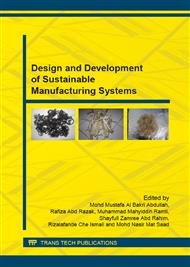[1]
Rangan, V.B., Design and manufacture of fly ash-based geopolymer concrete. Concrete in Australia, 2008. 34(2): pp.37-43.
Google Scholar
[2]
Davidovits, J., Global warming impact on the cement and aggregates industries. World Resource Review, 1994. 6: pp.263-278.
Google Scholar
[3]
Mustafa al-Bakri, A.M., et al., The relationship of NaOH molarity, Na2SiO3/NaOH ratio, fly ash/alkaline activator ratio, and curing temperature to the strength of fly ash-based geopolymer. Advanced in Materials Research, 2011. 328-330: pp.1475-1482.
DOI: 10.4028/www.scientific.net/amr.328-330.1475
Google Scholar
[4]
Davidovits, J., Mineral polymers and methods of making them. 1982: United States.
Google Scholar
[5]
Davidovits, J. Properties of geopolymer cements. in Proceedings First International Conference. 1994. Kiev, Ukraine: Geopolymer Institute, Saint-Quentin, France.
Google Scholar
[6]
Hardjito, D., et al., Fly ash-based geopolymer concrete. Australian Journal of Structural Engineering, 2005. 6: pp.1-9.
Google Scholar
[7]
Davidovits, J., Geopolymers: Inorganic polymeric new materials. Journal of Material Education, 1994. 16: pp.91-139.
Google Scholar
[8]
Slaty, F., et al., Durability of alkali activated cement produced from kaolinitic clay. Applied Clay Science, 2015. 104: pp.229-237.
DOI: 10.1016/j.clay.2014.11.037
Google Scholar
[9]
Davidovits, J., 30 years of successes and failures in geopolymer applications. Market trends and potential breakthroughs, in Geopolymer 2002 Conference. 2002, Geopolymer Institute, Saint-Quentin, France: Melbourne, Australia.
Google Scholar
[10]
Davidovits, J., High-alkali cements for 21st century concretes. In Concrete Technology, Past, Present and Future. 1994: Metha, P. K, American Concrete Institute, Farmington Hills.
DOI: 10.14359/4523
Google Scholar
[11]
van Jaarsveld, J.G.S. and J.S.J. van Deventer, The potential use of geopolymeric materials to immobilise toxic metals. Part 1. Theory and applications. Minerals Engineering, 1996. 10(7): pp.659-669.
DOI: 10.1016/s0892-6875(97)00046-0
Google Scholar
[12]
Heah, C.Y., et al., Kaolin-based geopolymers with various NaOH concentrations. International Journal of Minerals, Metallurgy andMaterials, 2013. 20: pp.313-322.
DOI: 10.1007/s12613-013-0729-0
Google Scholar
[13]
Mustafa al-Bakri, A.M., et al., Correlation between Na2SiO3/NaOH ratio and fly ash/alkaline activator ratio to the strength of geopolymer. Advanced Materials Research, 2012. 341-342: pp.189-193.
DOI: 10.4028/www.scientific.net/amr.341-342.189
Google Scholar
[14]
Cristobal, A.G.S., et al., Zeolites prepared from calcined and mechanically modified kaolins: A comparative study. Applied Clay Science, 2010. 49: pp.239-246.
DOI: 10.1016/j.clay.2010.05.012
Google Scholar
[15]
Liew, Y.M., et al., Processing and characterization of calcined kaolin cement powder. Construction and Building Materials, 2012. 30: pp.794-802.
DOI: 10.1016/j.conbuildmat.2011.12.079
Google Scholar
[16]
Davidovits, J., Geopolymer chemistry and applications. 2nd ed. 2008: Institute Geopolymere, 16 rue Galilee, 02100 Saint Quentin, France.
Google Scholar
[17]
Komnitsas, K. and D. Zaharaki, Geopolymerisation: A review and prospects for the minerals industry. Minerals Engineering, 2007. 20: pp.1261-1277.
DOI: 10.1016/j.mineng.2007.07.011
Google Scholar
[18]
Heah, C.Y., et al., Study on Solids-To-Liquid and Alkaline Activator Ratios on Kaolin-Based Geopolymers. Construction and Building Materials, 2012. 35: pp.912-992.
DOI: 10.1016/j.conbuildmat.2012.04.102
Google Scholar
[19]
Kong, D.L.Y., J.G. Sanjayan, and K. Sagoe-Crentsil, Comparative performance of geopolymers made with metakaolin and fly ash after exposure to elevated temperatures. Cement and Concrete Research, 2007. 37: pp.1583-1589.
DOI: 10.1016/j.cemconres.2007.08.021
Google Scholar
[20]
Zuhua, Z., et al., Role of water in the synthesis of calcined kaolin-based geopolymer. Applied Clay Science, 2009. 43: pp.218-223.
DOI: 10.1016/j.clay.2008.09.003
Google Scholar
[21]
Pelisser, F., et al., Micromechanical characterization of metakaolin-based geopolymers. Construction and Building Materials, 2013. 49: pp.547-553.
DOI: 10.1016/j.conbuildmat.2013.08.081
Google Scholar
[22]
Poowancum, A. and S. Horpibulsuk, Development of low cost geopolymers from calcined sedimentary clay, in Calcined Clays for Sustainable Concrete: Proceedings of the 1st International Conference on Calcined Clays for Sustainable Concrete A.F. Karen Scrivener, Editor. 2015, Springer.
DOI: 10.1007/978-94-017-9939-3_44
Google Scholar
[23]
Tempest, B., et al., Compressive strength and embodied energy optimization of fly ash based geopolymer concrete, in 2009 World of Coal Ash (WOCA). 2009: Lexington, KY, USA.
Google Scholar
[24]
Lin, K.L., et al., Effect of composition on characteristics of thin film transistor liquid crystal display (TFT-LCD) waste glass-metakaolin-based geopolymers. Construction and Building Materials, 2012. 36: pp.501-507.
DOI: 10.1016/j.conbuildmat.2012.05.018
Google Scholar
[25]
Zhang, Y.S., W. Sun, and Z.J. Li, Hydration process of potassium polysialate (K-PSDS) geopolymer cement. Advances in Cement Research, 2005. 17: pp.23-28.
DOI: 10.1680/adcr.2005.17.1.23
Google Scholar


